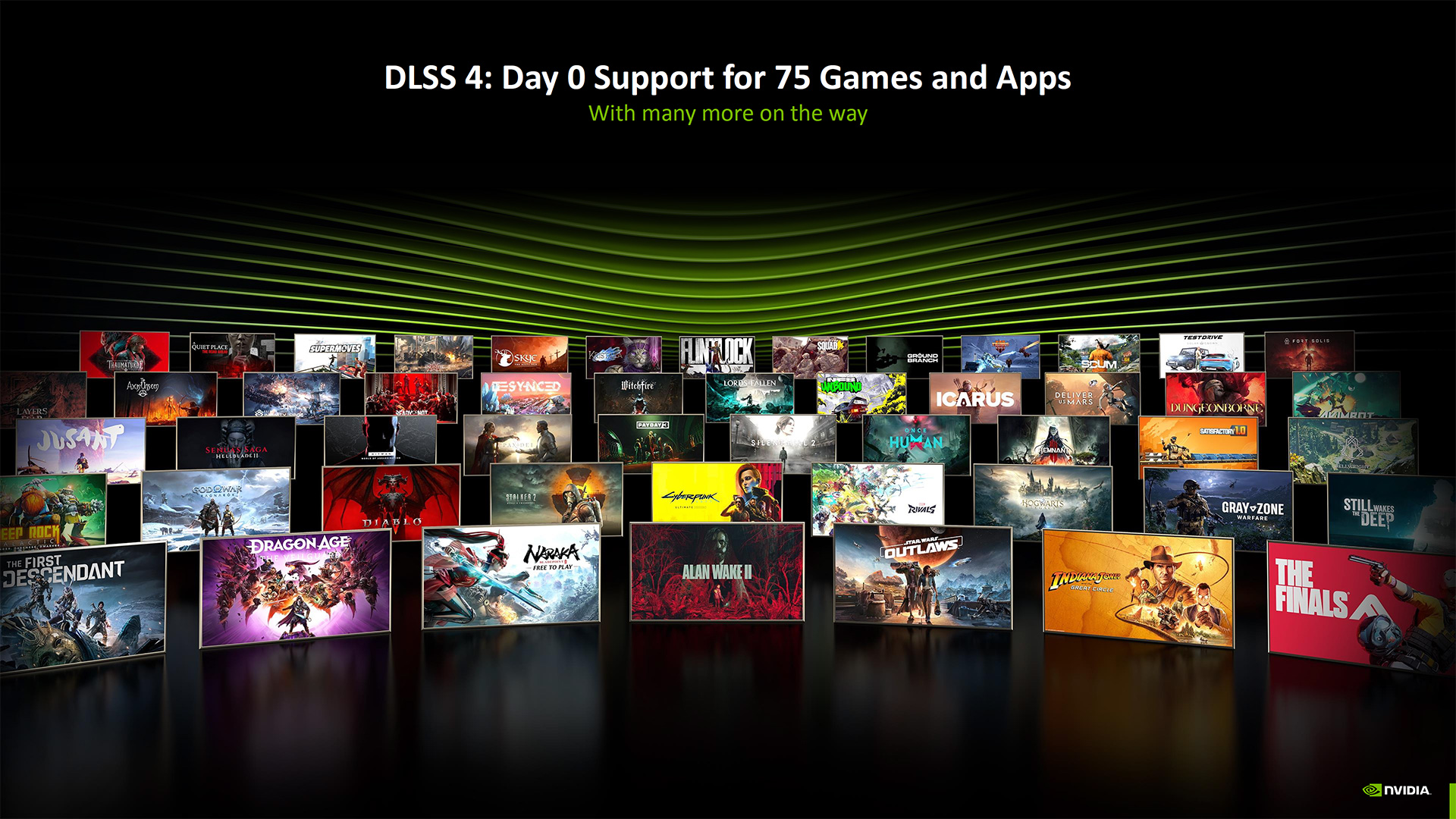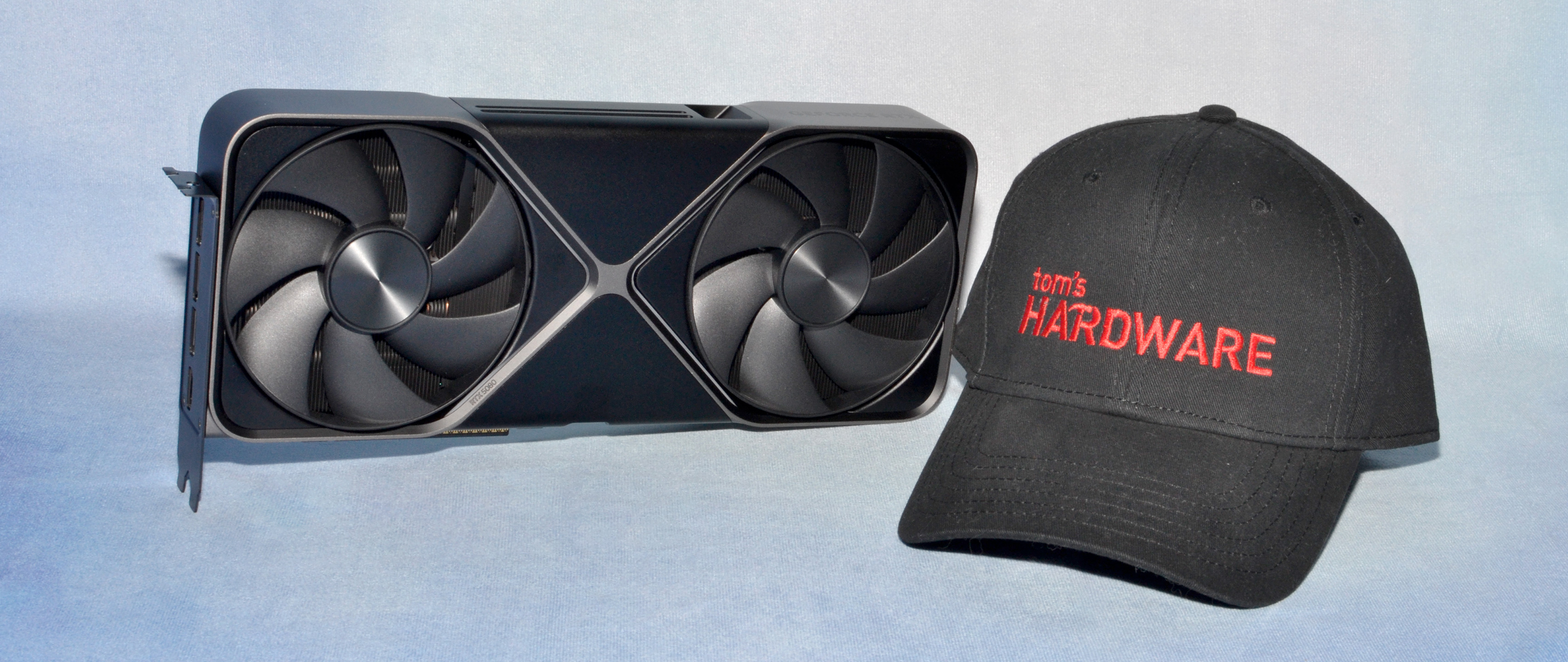Why you can trust Tom's Hardware
Nvidia RTX 5080 Full RT and DLSS 4 Testing (Ongoing...)
Testing the RTX 5080 in games that support DLSS 4 requires some extra effort. We're short on time still, but we're running benchmarks on several games and will update this page with full results later. But let's talk Multi Frame Generation for a bit. It's a key element in Nvidia's performance claims for the entire Blackwell family of GPUs. And, like DLSS 3 framegen, the resulting performance can be highly misleading.
Above, you can see a video in which Bryan Catanzaro, Nvidia's VP of Applied Deep Learning Research, discusses the changes to DLSS 4. Some changes only affect the RTX 50-series GPUs (for now?), while others apply to all RTX cards. DLSS upscaling is one that gets changed for everything with a new Transformers algorithm.
The short summary is that DLSS Transformers are more computationally intensive but yield better image quality results. We've played around with Cyberpunk 2077 and feel there's more to this than just marketing hype. Even with Balanced and Performance modes, DLSS Transformers can still look very good at 4K. It could actually deliver on Nvidia's "better than native" claims for DLSS.
What about Multi Frame Generation (MFG)? That's a different can of worms. As the name implies, it generates multiple frames rather than interpolating just one. It can run in three modes: 2X (generate a single frame), 3X (generate two frames), and 4X (generate three frames). Otherwise, in principle, it's a lot like the original framegen.
It takes two input images plus motion vectors and depth buffers and works to generate high-quality intermediate frames. In practice, there are some big changes compared to DLSS 3 on the RTX 40-series. MFG runs off the Blackwell tensor cores. We don't know if that means it can leverage the FP4 number format, but that would make sense. The OFA in the 40-series was a fixed function unit, and Nvidia apparently has reached the point where it can do better framegen via a software algorithm running a new AI model than by the old OFA. The new tensor-based framegen also runs faster than the OFA variant, even on an RTX 40-series GPU (or at least on the RTX 4090).

There are currently 75 games and applications that are DLSS 4 enabled, either with native support or via Nvidia App overrides. (Nearly all of them are via the Nvidia App right now.) You can use the new DLSS Transformers model to get improved image quality, with a slight hit to performance relative to the previously existing DLSS CNN (Convolutional Neural Network) models but with higher image quality. The performance hit does vary by the generation of hardware, however, and we expect transformers will run quite a bit slower than the CNN model on the 30- and 20-series RTX cards.
As for MFG, it's natively supported in the latest 2.2.1 Cyberpunk 2077 patch, and we ran some tests. We focused on 4K using RT-Overdrive (path tracing) for these tests. Unlike our initial 5090 testing, we've gone ahead and enabled DLSS Quality Transformers upscaling. Then, we tested with MFG at the three different levels, where applicable.
We'll add charts once we test a few more GPUs, but with just the 5080 and 5090 we have a reasonable start to sussing out just what MFG can feel like. And, as expected, it's a lot like DLSS3 (and FSR3) framegen. Succinctly, we feel like you need at least 30 FPS for rendered performance, and 40+ FPS is better, with MFG either doubling, tripling, or quadrupling that.
The resulting output on your monitor certainly looks smoother, but it doesn't necessarily feel that much better. The 5080, for example, got 36 FPS with 4K RT-Overdrive and DLSS Quality Transformers. Turning on MFG bumped that to 66, 95, and 122 FPS, with input sampling happening at 33, 32, and 31 FPS, respectively. That means responsiveness got worse at each level while the frame smoothing got better.
It was definitely playable, but it also definitely didn't feel at all like a game running at 66, 95, or 122 FPS. It felt more like a game running at maybe 35~40 FPS. And we're sure other games will have a different feel at various performance levels. With Cyberpunk 2077, we'd say you'll want to hit more like 80, 120, and 160 FPS at the three MFG levels to get a decent experience. Or alternatively, run with DLSS Performance mode upscaling to get a more responsive experience that doesn't look quite as smooth.
More to come....
Current page: Nvidia RTX 5080 Full RT and DLSS 4 Testing
Prev Page Nvidia RTX 5080 Ray Tracing Gaming Performance Next Page Nvidia RTX 5080: Content Creation, Professional Apps, and AIJarred Walton is a senior editor at Tom's Hardware focusing on everything GPU. He has been working as a tech journalist since 2004, writing for AnandTech, Maximum PC, and PC Gamer. From the first S3 Virge '3D decelerators' to today's GPUs, Jarred keeps up with all the latest graphics trends and is the one to ask about game performance.
-
cknobman Pretty darn dissapointing.Reply
Sit back and let the impatient suckers get fleeced.
I'll happily wait for March and see if AMD can offer something worth buying at $500. -
King_V I initially looked at the TDP numbers, and thought: a new architecture, slightly more than 10% extra power draw for slightly less than 10% extra performance, on average, for gaming.Reply
But, that it actually doesn't exceed the power consumption during use of the 4080 Super is nice to see.
Still, yeah, if you're in the market for a GPU with this performance, and if the price is the same, the 5080 is the way to go.
But, I feel like the odds are that, at least for a few months, the 5080 will cost more, and the 4080 Super prices MIGHT come down a little with the release of the 5000 series. If so, that situation could make the 5080 a hard sell. -
spongiemaster Reply
5090 is more than 50% faster than 5080 which is ridiculous. There's something to be said for trying to upsell, but that's way too big a gap in performance and cost between the 5080 and 5090. Also sounds like there are issues with volume production as well. Getting people to move up doesn't work if you don't have product to sell them. If you're in the market for a 5080, wait for the refresh. Will likely have more VRAM and will hopefully gain some meaningful ground in performance.Gururu said:It's so cheap though, $1000 less than the 5090. -
TCA_ChinChin How is "second fastest GPU" a positive? Its not even true, the 4090 is the second fastest GPU. This is the worst 80 series release by Nvidia for a while now. Im pretty sure the last 4-5 generations of 80 series cards have outperformed the previous generation flagship (except the 2080 vs 1080ti which was also a quite disappointing generation).Reply -
Elusive Ruse Thank you @JarredWaltonGPU for the detailed review and pointing out the flaws of this underwhelming product. The 80 class is officially dead? I wish you had the time to include the 3090 as well so we could see how 4080 performed against it and in turn highlight the fact that the 5080 doesn’t even come close to the 4090.Reply
I was in the market for a 5080 but my excitement died down gradually with the leaks about its specs over the past few months and with the reviews out I’m definitely not planning to throw €1200+ at it. -
spongiemaster Reply
5080 is 50% faster than the 3090 at 4k. So a decent upgrade for 3090 users for less money than they spent on their 3090 though there is a memory downgrade. Still would recommend waiting for the refresh.Elusive Ruse said:I wish you had the time to include the 3090 as well so we could see how 4080 performed against it and in turn highlight the fact that the 5080 doesn’t even come close to the 4090. -
I'm getting the impression that the reason behind 5080 being so disappointing, is Nvidia trying to funnel consumers into buying the extremely inflated 5090.Reply


